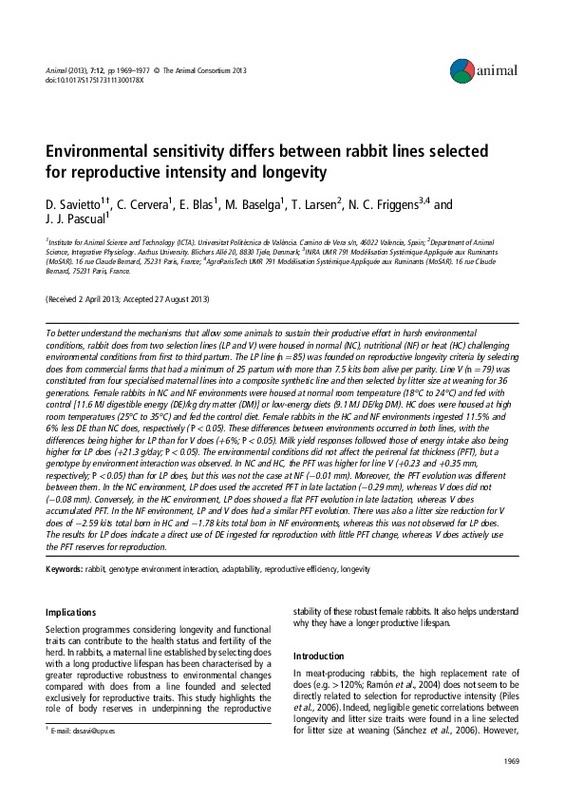Vicente, J. S., Llobat, L., Viudes-de-Castro, M. P., Lavara, R., Baselga, M., & Marco-Jiménez, F. (2012). Gestational losses in a rabbit line selected for growth rate. Theriogenology, 77(1), 81-88. doi:10.1016/j.theriogenology.2011.07.019
Theilgaard, P., Sánchez, J., Pascual, J., Berg, P., Friggens, N. C., & Baselga, M. (2007). Late reproductive senescence in a rabbit line hyper selected for reproductive longevity, and its association with body reserves. Genetics Selection Evolution, 39(2), 207. doi:10.1186/1297-9686-39-2-207
Savietto, D., Blas, E., Cervera, C., Baselga, M., Friggens, N. C., Larsen, T., & Pascual, J. J. (2012). Digestive efficiency in rabbit does according to environment and genetic type. World Rabbit Science, 20(3). doi:10.4995/wrs.2012.1152
[+]
Vicente, J. S., Llobat, L., Viudes-de-Castro, M. P., Lavara, R., Baselga, M., & Marco-Jiménez, F. (2012). Gestational losses in a rabbit line selected for growth rate. Theriogenology, 77(1), 81-88. doi:10.1016/j.theriogenology.2011.07.019
Theilgaard, P., Sánchez, J., Pascual, J., Berg, P., Friggens, N. C., & Baselga, M. (2007). Late reproductive senescence in a rabbit line hyper selected for reproductive longevity, and its association with body reserves. Genetics Selection Evolution, 39(2), 207. doi:10.1186/1297-9686-39-2-207
Savietto, D., Blas, E., Cervera, C., Baselga, M., Friggens, N. C., Larsen, T., & Pascual, J. J. (2012). Digestive efficiency in rabbit does according to environment and genetic type. World Rabbit Science, 20(3). doi:10.4995/wrs.2012.1152
Rosell, J. M., & de la Fuente, L. F. (2009). Culling and mortality in breeding rabbits. Preventive Veterinary Medicine, 88(2), 120-127. doi:10.1016/j.prevetmed.2008.08.003
Sánchez, J. P., de la Fuente, L. F., & Rosell, J. M. (2012). Health and body condition of lactating females on rabbit farms1. Journal of Animal Science, 90(7), 2353-2361. doi:10.2527/jas.2011-4065
Quevedo, F., Cervera, C., Blas, E., Baselga, M., Costa, C., & Pascual, J. J. (2005). Effect of selection for litter size and feeding programme on the performance of young rabbit females during rearing and first pregnancy. Animal Science, 80(2), 161-168. doi:10.1079/asc40850161
Pascual, J. J., Motta, W., Cervera, C., Quevedo, F., Blas, E., & Fernández-Carmona, J. (2002). Effect of dietary energy source on the performance and perirenal fat thickness evolution of primiparous rabbit does. Animal Science, 75(2), 267-279. doi:10.1017/s1357729800053029
Friggens, N. C., Brun-Lafleur, L., Faverdin, P., Sauvant, D., & Martin, O. (2011). Advances in predicting nutrient partitioning in the dairy cow: recognizing the central role of genotype and its expression through time. animal, 7(s1), 89-101. doi:10.1017/s1751731111001820
Fernández-Carmona, J., Cervera, C., Sabater, C., & Blas, E. (1995). Effect of diet composition on the production of rabbit breeding does housed in a traditional building and at 30°C. Animal Feed Science and Technology, 52(3-4), 289-297. doi:10.1016/0377-8401(94)00715-l
Blas, C. de, & Mateos, G. G. (s. f.). Feed formulation. Nutrition of the rabbit, 222-232. doi:10.1079/9781845936693.0222
Brecchia, G., Bonanno, A., Galeati, G., Federici, C., Maranesi, M., Gobbetti, A., … Boiti, C. (2006). Hormonal and metabolic adaptation to fasting: Effects on the hypothalamic–pituitary–ovarian axis and reproductive performance of rabbit does. Domestic Animal Endocrinology, 31(2), 105-122. doi:10.1016/j.domaniend.2005.09.006
Sánchez, J. P., Theilgaard, P., Mínguez, C., & Baselga, M. (2008). Constitution and evaluation of a long-lived productive rabbit line1. Journal of Animal Science, 86(3), 515-525. doi:10.2527/jas.2007-0217
Mehaisen, G., Vicente, J., & Lavara, R. (2004). In Vivo Embryo Recovery Rate by Laparoscopic Technique from Rabbit Does Selected for Growth Rate. Reproduction in Domestic Animals, 39(5), 347-351. doi:10.1111/j.1439-0531.2004.00526.x
Harano, Y., Ohtsuki, M., Ida, M., Kojima, H., Harada, M., Okanishi, T., … Shigeta, Y. (1985). Direct automated assay method for serum or urine levels of ketone bodies. Clinica Chimica Acta, 151(2), 177-183. doi:10.1016/0009-8981(85)90321-3
Engblom, L., Lundeheim, N., Dalin, A.-M., & Andersson, K. (2007). Sow removal in Swedish commercial herds. Livestock Science, 106(1), 76-86. doi:10.1016/j.livsci.2006.07.002
Fernández-Carmona, J., Alqedra, I., Cervera, C., Moya, J., & Pascual, J. J. (2003). Effect of lucerne-based diets on performance of reproductive rabbit does at two temperatures. Animal Science, 76(2), 283-295. doi:10.1017/s1357729800053534
Piles, M., Garreau, H., Rafel, O., Larzul, C., Ramon, J., & Ducrocq, V. (2006). Survival analysis in two lines of rabbits selected for reproductive traits1. Journal of Animal Science, 84(7), 1658-1665. doi:10.2527/jas.2005-678
Theilgaard, P., Baselga, M., Blas, E., Friggens, N. C., Cervera, C., & Pascual, J. J. (2009). Differences in productive robustness in rabbits selected for reproductive longevity or litter size. animal, 3(5), 637-646. doi:10.1017/s1751731109003838
Ferrian, S., Blas, E., Larsen, T., Sánchez, J. P., Friggens, N. C., Corpa, J. M., … Pascual, J. J. (2013). Comparison of immune response to lipopolysaccharide of rabbit does selected for litter size at weaning or founded for reproductive longevity. Research in Veterinary Science, 94(3), 518-525. doi:10.1016/j.rvsc.2013.01.008
Xiccato, G., Bernardini, M., Castellini, C., Dalle Zotte, A., Queaque, P. I., & Trocino, A. (1999). Effect of postweaning feeding on the performance and energy balance of female rabbits at different physiological states. Journal of Animal Science, 77(2), 416. doi:10.2527/1999.772416x
Ragab, M., & Baselga, M. (2011). A comparison of reproductive traits of four maternal lines of rabbits selected for litter size at weaning and founded on different criteria. Livestock Science, 136(2-3), 201-206. doi:10.1016/j.livsci.2010.09.009
García-Diego, F.-J., Pascual, J. J., & Marco, F. (2011). Technical Note: Design of a large variable temperature chamber for heat stress studies in rabbits. World Rabbit Science, 19(4). doi:10.4995/wrs.2011.938
Littell, R. C., Henry, P. R., & Ammerman, C. B. (1998). Statistical analysis of repeated measures data using SAS procedures. Journal of Animal Science, 76(4), 1216. doi:10.2527/1998.7641216x
Cervera, C., & Carmona, J. F. (s. f.). Nutrition and the climatic environment. Nutrition of the rabbit, 267-284. doi:10.1079/9781845936693.0267
Sanchez, J. P., Baselga, M., & Ducrocq, V. (2006). Genetic and environmental correlations between longevity and litter size in rabbits. Journal of Animal Breeding and Genetics, 123(3), 180-185. doi:10.1111/j.1439-0388.2006.00590.x
Quevedo, F., Cervera, C., Blas, E., Baselga, M., & Pascual, J. J. (2006). Long-term effect of selection for litter size and feeding programme on the performance of reproductive rabbit does 1. Pregnancy of multiparous does. Animal Science, 82(5), 739-750. doi:10.1079/asc200687
Estany, J., Baselga, M., Blasco, A., & Camacho, J. (1989). Mixed model methodology for the estimation of genetic response to selection in litter size of rabbits. Livestock Production Science, 21(1), 67-75. doi:10.1016/0301-6226(89)90021-3
Estany, J., Camacho, J., Baselga, M., & Blasco, A. (1992). Selection response of growth rate in rabbits for meat production. Genetics Selection Evolution, 24(6), 527. doi:10.1186/1297-9686-24-6-527
[-]









